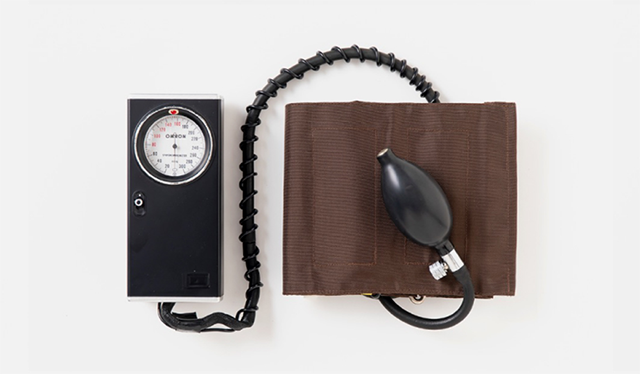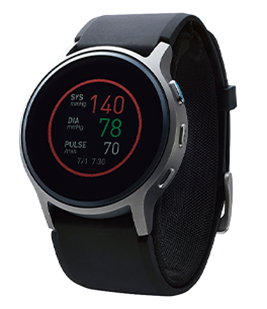
Although today monitoring blood pressure at home is an ordinary scene in everyday life, when OMRON launched its first electronic home-use blood pressure monitor in 1973, home blood pressure monitoring was not yet commonplace. Now about 50 years later in 2021, blood pressure monitors for home use are widespread across the globe. In particular, OMRON's blood pressure monitors are used in homes in over 110 nations and regions around the world. This year global sales of our blood pressure monitors topped 300 million units, and we maintain the largest share in the market worldwide. In this article we will introduce our journey that led to selling 300 million units and next steps.
ŃĆĆ
When OMRON launched its first electronic blood pressure monitor for home use in 1973, blood pressure was seen as something that could only be monitored by a physician at a hospital. Since monitoring blood pressure required specialized knowledge and skills, it was considered too difficult of a task for people to do by themselves at home. But OMRON believed that home blood pressure monitoring could benefit people's health. So we have pursued the development of products that would be easy enough for anyone to use at home, but accurate enough to be used at hospitals as well. We also participated in numerous clinical studies and carried out awareness-raising activities in collaboration with healthcare professionals and experts to promote home blood pressure monitoring and convey its importance across Japan and the entire world.
 HEM-1, OMRON's First Electronic Blood Pressure Monitor, Manometer-typed Manual Monitor
HEM-1, OMRON's First Electronic Blood Pressure Monitor, Manometer-typed Manual MonitorA large-scale clinical research project called the "Ohasama Study" was initiated in 1986 and its findings would become the basis for the current reference value of 135/85 mmHg for blood pressure monitored at home. The study took place in the small town of Ohasama-machi in Iwate Prefecture, an area which had a high incidence of hypertension and stroke. The purpose of the study was to monitor blood pressure in daily life and research the relationship between blood pressure and illness to ascertain and improve the situation for the residents. OMRON provided 300 home-use blood pressure monitors without charge, and this was the start of the study using the guidelines of self-measured blood pressure at home. Working with healthcare professionals, we strove to promote and raise awareness on home blood pressure monitoring .
The Ohasama Study discovered that blood pressure monitored at home has a closer association with stroke risk than blood pressure monitored at a physician's office. These results led to the development of the reference value of 135/85 mmHg and even influenced international guidelines. And in 2014, 28 years after the study began, the efforts bore fruit. The Japanese Society of Hypertension Guidelines for the Management of Hypertension (JSH2014) stipulated that home blood pressure shall be prioritized over clinic blood pressure in hypertension treatment, recognizing the effectiveness of monitoring blood presser at home in hypertension treatment. After that, home blood pressure monitoring became the standard in hypertension treatment not only in Japan but across the globe.
ŃĆĆ
It took as long as 36 years since the launch of our first blood pressure monitor to achieve sales of over 100 million units in 2009. After that, home blood pressure monitoring became more prevalent due to a rise in health-consciousness, the worldwide increase in people suffering from lifestyle diseases, and the development of hypertension treatment guidelines for home blood pressure monitoring. And seven years after reaching 100 million in unit sales, in 2016 we reached 200 million. The blood pressure monitor market continued to grow across the globe after that. Demand increased not only in Europe, the US, and China, but also in emerging economies such as India and Brazil. By 2021, only five years later, we topped 300 million units.
The COVID-19 pandemic has led to an even greater increase in health consciousness. Our blood pressure monitor sales in fiscal 2020 grew to 2.4 million units globally, achieving a 20% year-on-year increase. Thanks to the effectiveness of home blood pressure monitoring being recognized, the practice of measuring blood pressure at home continues to spread globally.
ŃĆĆ
Currently, some one billion people worldwide are reported to have hypertension. In Japan, this number is estimated to be 43 million. The most frightening aspect of hypertension is that disease progression usually occurs without symptoms, yet it still can cause serious cerebrovascular or cardiovascular conditions such as stroke and heart attack.
Japan too has seen its second biggest killer in 2017 being heart disease including heart attack, with the third ranked killer being cerebrovascular diseases such as cerebral infarction and cerebral hemorrhage. Taken together, all these diseases represent health issues that must be addressed.
True to its mission "to help realize healthy and comfortable lives for people around the world," OMRON Healthcare continues to take on new challenges to achieve zero cerebro-cardiovascular events such as stroke and heart failure. In addition to developing blood pressure monitors, today we are also tackling challenges such as expanding remote healthcare services globally, which show promise to create a new medical infrastructure, and developing algorithms that use AI to prevent cerebro-cardiovascular diseases.
 HeartGuide, a Wearable Blood Pressure Monitor Watch Launched in 2019
HeartGuide, a Wearable Blood Pressure Monitor Watch Launched in 2019Conventional treatment of hypertension and heart disease used to be based on a patient treatment plan formulated by a physician utilizing data from the patient's vital signs at the physician's office. But as blood pressure fluctuates all the time, the data obtained at a physician's office alone is not optimal for identifying the patient's blood pressure change trends in detail. This for example made it difficult to evaluate the efficacy of the medication prescribed. For coping with this kind of issue, Omron Healthcare launched Remote Patient Monitoring services that enable physicians to remotely monitor health data recorded by the patient at home, then use them for early-stage detection and treatment of abnormal conditions.
In September 2020, we launched VitalSightŌäó, a remote patient monitoring system for chronic disease such as hypertension in North America. Then in April 2021 we began offering services to solve new social problems that have emerged across the globe, such as Hypertension Plus, a remote patient monitoring service for patients with hypertension in the UK. We are also moving forward with remote patient monitoring services in collaboration with corporate partners in Singapore, India, and Brazil, and rolling out services that take into account the health insurance systems and clinical needs of different countries. And as the global COVID-19 pandemic has created new challenges in face-to-face healthcare services and brought about changes in people's values and lifestyles, we believe expectations for widespread use of remote patient monitoring services will be even greater going forward.
In Japan, we started a collaborative research program called "Healthcare Medical AI" with Kyoto University in June 2021. Through the program, we are working to develop algorithms that would detect signs of cerebro-cardiovascular diseases by using AI technology to analyze multiple types of data such as daytime and nighttime blood pressure measured at home, body weight, and amount of activity. We are also conducting research on methods for improving blood pressure that are tailored to individuals' lifestyles and characteristics. By combining OMRON's biodata measuring technology and Kyoto University's AI technology, we are aiming to be able to detect early signs of cerebro-cardiovascular diseases and provide individualized blood pressure improvement methods, with the ultimate goal of achieving zero cerebro-cardiovascular events.
Global sales of 300 million units of blood pressure monitors is not our goal, but just a passing point. In addition to the promotion of blood pressure monitoring, OMRON Healthcare will continue working towards the goal of achieving zero cerebro-cardiovascular events by closely working with medical institutions and accelerating initiatives to lower the risk of disease and prevent it from getting worse.